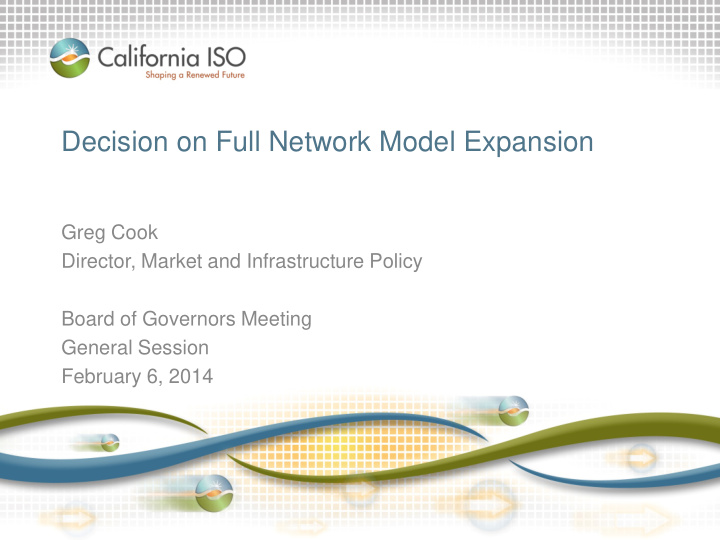



Decision on Full Network Model Expansion Greg Cook Director, Market and Infrastructure Policy Board of Governors Meeting General Session February 6, 2014
The full network model expansion increases the ISO’s modeling capabilities. Modeled WECC WECC BAA (Illustrative (Illustrative interties in red) interties in red) Modeled BAA Slide 2
The full network model expansion provides increased reliability and market efficiency benefits. • Improved reliability: Provides greater visibility to outages and contingencies in the day-ahead time frame • Improved market efficiency: • More accurate market pricing and fewer infeasible schedules, • More accurate energy imbalance market modeling • Builds upon joint recommendations from the FERC and the North American Electric Reliability Corporation pursuant to the September 8, 2011 blackout event. Slide 3
Unscheduled loop flows are caused by the difference between contract path scheduling and how energy actually flows. Contract path scheduling Actual flow Slide 4
The full network model expansion addresses current challenges caused by unscheduled flows. • Model external balancing areas so that the ISO can reflect outages and conduct contingency analyses and other reliability assessments • Model the energy transactions in external balancing areas to forecast the unscheduled loop flow impact on the ISO system • Extend modeling of the physical flows and limits at the interties to the day-ahead Slide 5
Additional changes are proposed to align with and facilitate the full network model expansion. • Separate treatment for California Oregon Intertie (COI) – responsive to stakeholder comments by retaining today’s treatment and using established WECC mitigation procedure in real-time • Congestion revenue rights model – will include changes from the full network model Slide 6
Stakeholders largely support including unscheduled flows in the day-ahead market, however some concerns have been raised. • ISO’s day-ahead market should not manage loop flows attributable to other balancing areas in western interconnection • ISO should adjust intertie scheduling limits to reflect loop flows rather than use physical flow limits in the day-ahead market • Estimates of external balancing area generation, load, and interchange data may not be accurate Slide 7
Pre-implementation analysis ensures that the full network model accurately reflects unscheduled flows before implementation. • Management commits to a pre-implementation analysis to validate the proposed modeling methodologies – Various calibration tools will be used to fine-tune the approach • The analysis will be conducted in Summer 2014, once the ISO receives the software code from its vendors • The results of the analysis will be reported to the Board at the September 2014 meeting Slide 8
Management recommends the Board approve the proposal. • There is broad support for accurately modeling unscheduled loop flows in the day-ahead market • The full network model expansion design provides increased reliability and market efficiency • Full network model expansion helps to facilitate energy imbalance market implementation Slide 9
Recommend
More recommend